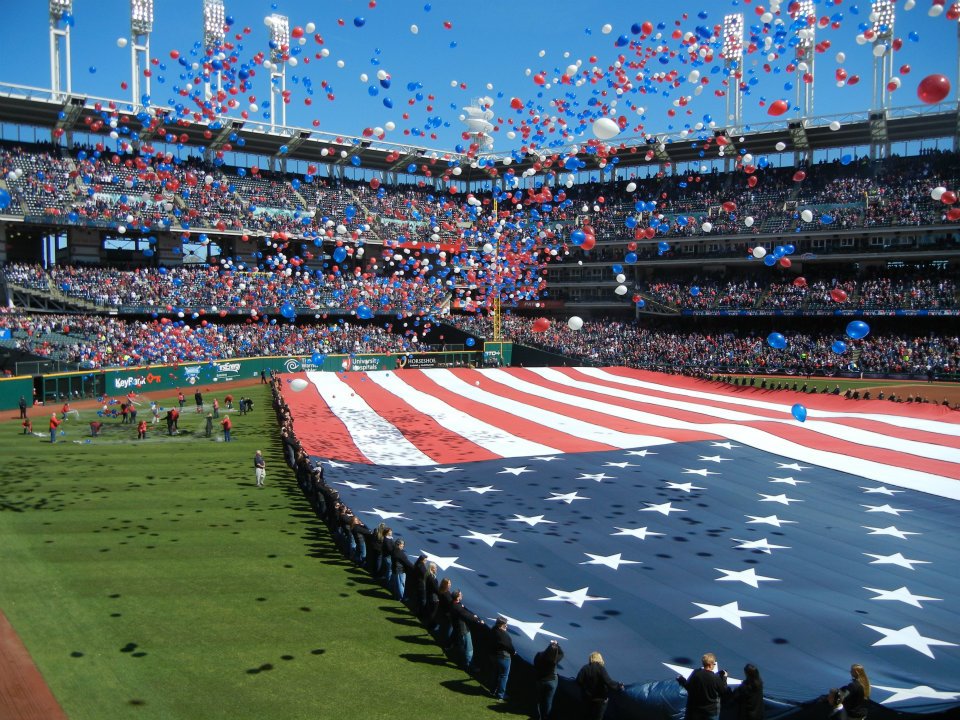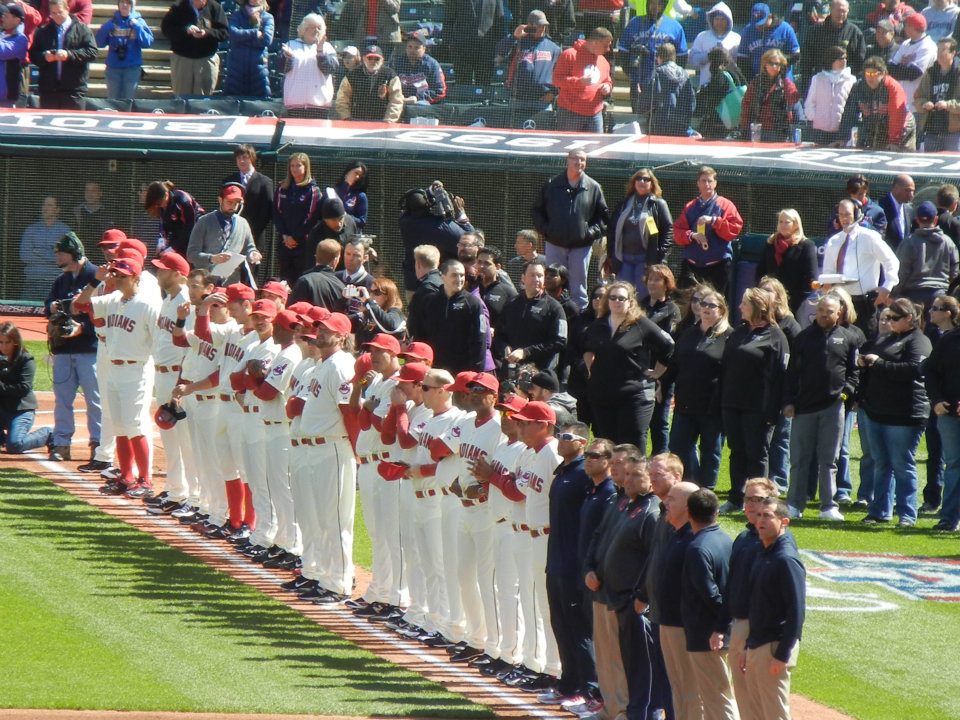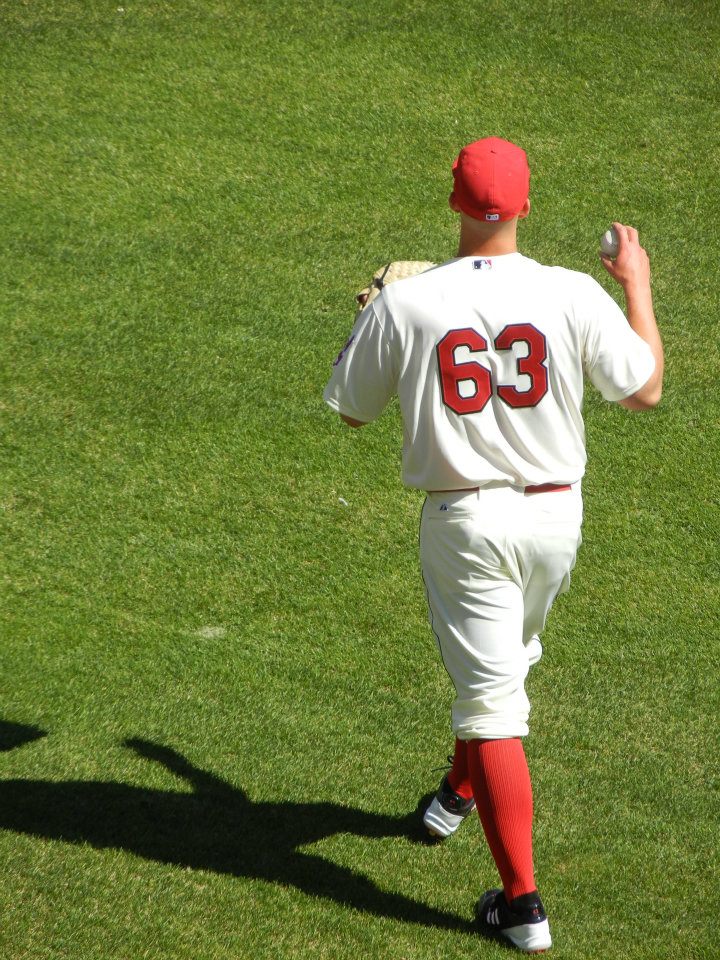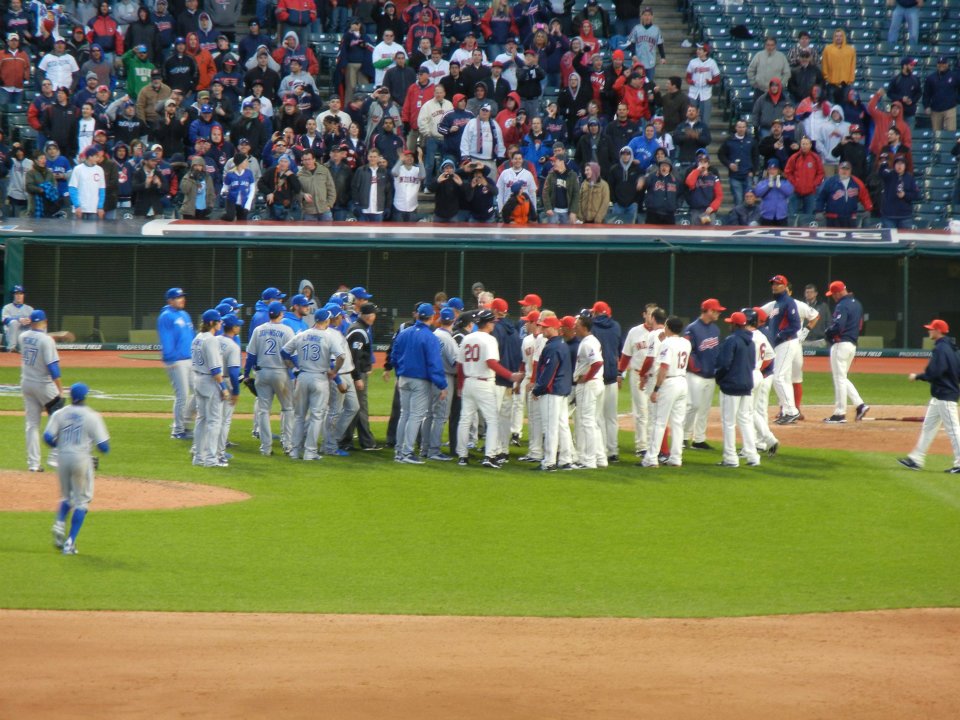 Indians Archive
Indians Archive  View from the Porch: Not So Sweet Sixteen
View from the Porch: Not So Sweet Sixteen
 As I helplessly watched JP Arencibia’s game-winning three-run homer fly directly over my head on the Home Run Porch, I couldn’t help but think about how the Indians Home Opener seems to be a microcosm for life as a Cleveland sports fan. Every year, we get all excited about the chance to watch the first home game of a new season. Optimism runs high. We’re all giddy. It’s a great time to be a sports fan, taking part in the fanfare of the start of a new campaign. The oversized American flag on the field. Player introductions. New graphics and videos on the scoreboard.
As I helplessly watched JP Arencibia’s game-winning three-run homer fly directly over my head on the Home Run Porch, I couldn’t help but think about how the Indians Home Opener seems to be a microcosm for life as a Cleveland sports fan. Every year, we get all excited about the chance to watch the first home game of a new season. Optimism runs high. We’re all giddy. It’s a great time to be a sports fan, taking part in the fanfare of the start of a new campaign. The oversized American flag on the field. Player introductions. New graphics and videos on the scoreboard.
Then one of two things happens. Our team wins and we begin to place unrealistic expectations on the entire season. We jump and cheer, stand and applaud, and the tone of our voice reaches a higher pitch. One game means everything in the 16, 82, or 162-game season. In that moment, we’re going to be a playoff team, or at the very least a contender until the end, no matter what the prognostications and predictions say.
The other thing that happens is that our team loses and the anticipation and anxiety we felt before the game is replaced by despair and frustration. It’s a crushing blow to the season. Boos rain down from the last row of the cheap seats and fans call for the players' heads. Everybody becomes a Monday morning quarterback, putting the game under a microscope because it’s the only game to talk about. Knee-jerk reactions and opinions get blurted out without any reservation or perspective.
Such is life in the most tortured sports city in America. I wish I had something to talk about in regards to the Home Opener. I wish something of interest would have happened so that I didn’t have to fill this week’s column with prepositional phrases, clichés, and overused expressions like I used to do with the majority of my papers in college. Unfortunately, that didn’t happen and it was your everyday 16-inning Major League Baseball game with umpires stealing the show, a bench clearing incident nearly five hours after the game had started, a blown save by the already-maligned closer, and a lack of execution from both teams.
Might as well begin this week’s View from the Porch by congratulating myself and my fiancée for gracing the cover of Friday’s Akron Beacon Journal with our glorious presence. Right on the top of the front page. Quite the surprising Facebook wall post I awoke to this morning from a kid who I rarely talk to and only had a couple of classes with in college telling me that I “had a nice picture on the cover of the Beacon”. It pays to be in line at the gate three hours before the game starts! (Oh, and all pictures in this article were taken by my fiancee, Jennifer. Nice job, babe!)
 Now that that’s out of the way, let’s get to the game. We’ll start with the bad and finish with the good because that’s the way we should do it when 99.38% of the season is left to be played. Chris Perez has to headline this section of the VftP. He was, quite simply, atrocious. If you want to re-live Thursday’s ninth inning, and you probably don’t, Fangraphs summed it up pitch-by-painstaking-pitch. A lot of intelligent baseball people don’t think very highly of Chris Perez. There are many levels to the discussion that have to be considered.
Now that that’s out of the way, let’s get to the game. We’ll start with the bad and finish with the good because that’s the way we should do it when 99.38% of the season is left to be played. Chris Perez has to headline this section of the VftP. He was, quite simply, atrocious. If you want to re-live Thursday’s ninth inning, and you probably don’t, Fangraphs summed it up pitch-by-painstaking-pitch. A lot of intelligent baseball people don’t think very highly of Chris Perez. There are many levels to the discussion that have to be considered.
First, the issue with Perez’s velocity. This is first and foremost because at 91 mph, his fastball is simply not good enough to be doing anything other than mop up work or middle relief. Before I delve into the numbers, in Perez’s defense, the radar gun readings looked low for everybody during the chilly Opener. I’m not sure Justin Masterson touched 92 more than a couple of times and his average fastball velocity, according to Fangraphs, in 2011 was 92.7. That obviously means he touched 94-95 from time to time. Vinnie Pestano didn’t get above 92, and he regularly threw 96+ in 2011. So, the cold weather was definitely a factor.
But, this isn’t a new thing with Chris Perez. Last year, his average fastball velocity dropped 1.2 mph from his 2010 readings. As a result, he struck out fewer hitters, had a much higher contact rate, and had 2% fewer swinging strikes than the year before. There isn’t enough deception in his arm angle and release point to throw hitters off the scent of his straight fastball. He often has trouble spotting his slider and becomes a one-pitch pitcher, which is when opposing hitters feast off of him. This is a big concern to monitor going forward.
Second, is/was there reason to justify removing him from the closer’s role? In 2011, despite his lower K numbers and higher WHIP, Perez was 36/40 in saves with a 2.75 ERA in save situations and a 1.13 WHIP, 6.3 K/9, and 1.73 K/BB ratio. He was significantly worse in non-save situations, with a 4.18 ERA, 1.31 WHIP, and only a 1.17 K/BB ratio. Can you really say that he doesn’t deserve the job after getting it done 90% of the time?
Obviously, there are a lot of concerns, but there’s protocol that a manager has to follow. Managing a player’s psyche is just as important as ensuring positive results. Manny Acta could have hid under the guise of Chris Perez’s Spring Training oblique injury and sent him to Columbus on a rehab stint to open the season. They felt he was healthy enough. Maybe they’re regretting that decision now.
Third, and this may be a counter-intuitive point to some of you, you weaken the bullpen as a whole if Chris Perez doesn’t close. Let’s assume that the obvious choice, Vinnie Pestano, would become the closer if Chris Perez faltered. That would put Joe Smith into your 8th inning righty role. Who would pitch the 6th/7th against righties if Smith were your 8th inning guy? Do we want to trust Rafael Perez or Tony Sipp against righties? I don’t. What about Dan Wheeler or Jairo Asencio? Chris Perez, since becoming closer, has struggled immensely in non-save situations. In theory, big spots in the 6th/7th would be “save” situations, but do we want to chance our ex-closer in, arguably, just as crucial of a spot? You can’t lose a game in the 6th/7th like you can in the 9th, but it can still have an impact. Moving guys out of the roles that they’ve excelled in can have negative consequences.
Finally, Chris Perez blew a save. It happens to everybody. Golden boy Jose Valverde blew one on Thursday. Mariano Rivera blew one on Friday, after he was 60/61 in his last 61 chances against the Rays and hadn’t blown one against them since September 2005. It happens. It’s only magnified by the prestige of the day. If he did it on May 18, would we care as much? Would it have been discussed this much? Probably not. But, because we have an off day and nothing else to talk about, he needs to be removed from the closer’s role and sent to Siberia.
 Oh, and on the subject of leaving Masterson in, no. I agree with Manny Acta. Under no circumstances does he come back out to throw 110+ pitches on a 45 degree day when he wasn’t really stretched out much in Spring Training. Jim Leyland pulled Justin Verlander after eight innings and 105 pitches. Charlie Manuel pulled Roy Halladay after eight innings and 92 pitches. One guy won, the other two didn’t. They all made the exact same call with their starting pitcher.
Oh, and on the subject of leaving Masterson in, no. I agree with Manny Acta. Under no circumstances does he come back out to throw 110+ pitches on a 45 degree day when he wasn’t really stretched out much in Spring Training. Jim Leyland pulled Justin Verlander after eight innings and 105 pitches. Charlie Manuel pulled Roy Halladay after eight innings and 92 pitches. One guy won, the other two didn’t. They all made the exact same call with their starting pitcher.
As for my point above about umpires stealing the show, the warning to both benches after Justin Masterson supposedly threw at Kelly Johnson was embarrassing. Shin-Soo Choo was hit in the back leading off the third inning by Ricky Romero, who would have had trouble finding the plate if Lewis and Clark were showing him where it was on a map. There was no intent there. Justin Masterson, who has struggled in the past to pitch effectively against lefties because his arm angle and movement on the sinker make it hard for him to use the inner half of the plate against them, tried to pitch Kelly Johnson inside on consecutive pitches, both way too far inside. Home plate umpire Tim Welke picked this time to unzip his pants and show his authority to both benches, and especially Masterson, by very animatedly warning both teams.
Talk about having no pulse for the game. Masterson obviously wants to hit the guy batting in front of Jose Bautista with a four-run lead. I can’t believe Masterson had the incredible stat line that he did under the fear of pitching inside and possibly getting tossed. Tim Welke should be ashamed of himself. Every pitcher absolutely must have the right to pitch inside. Somehow, it didn’t really affect the outcome of the game, but it really could have.
 Oh, and to top it off, when Luis Perez nearly beheaded Shin-Soo Choo with a pitch in the 15th inning, Perez wasn’t tossed. Choo threw his bat down and marched toward the mound as the sad looking army of remaining bullpen members charged in to meet their teammates at the center of the diamond. Unfortunately, the Indians couldn’t feed off Choo’s fighting spirit. Why give a warning if you aren’t going to toss a guy for throwing near a guy’s dome? Intentional or not, why pick the 15th inning to start using judgment as a home plate ump? I wish Choo would have kicked the guy’s ass.
Oh, and to top it off, when Luis Perez nearly beheaded Shin-Soo Choo with a pitch in the 15th inning, Perez wasn’t tossed. Choo threw his bat down and marched toward the mound as the sad looking army of remaining bullpen members charged in to meet their teammates at the center of the diamond. Unfortunately, the Indians couldn’t feed off Choo’s fighting spirit. Why give a warning if you aren’t going to toss a guy for throwing near a guy’s dome? Intentional or not, why pick the 15th inning to start using judgment as a home plate ump? I wish Choo would have kicked the guy’s ass.
Now that we’ve all had a day to digest the first game of the season and overthink and overanalyze everything that happened over the first 16 innings of the season, it’s time to move forward. Another interesting Home Opener in the books. Last year, we were down 14-0 after four innings. In 2010, Jamey Wright gave up a two-run HR to Nelson Cruz in the top of the 10th to lose 4-2. In 2009, against the same Blue Jays, the game started at 3:05 and ended at nearly 11:30 after almost four hours worth of a rain delay just to lose 13-7 thanks a six-run 8th for the Blue Jays. We needed a three-run 8th to win in 2008 after blowing a 7-2 lead after two. The 2007 one speaks for itself. Basically, the running trend here is that the Indians cannot play an easy, nine-inning, Home Opener win.
Doom and gloom aside, there were quite a few good things from the Home Opener and hopefully some trends that will continue. The Indians walked 11 times, granted, over 16 innings, that number is a little watered down, but they had Ricky Romero’s pitch count elevated very early in the game and made most of Toronto’s pitchers work hard to get outs. The Indians got themselves into a lot of good hitter’s counts, but just didn’t make the most of them. Blue Jays hurlers had to throw 280 pitches. Given the 49 at bats, 11 walks, a sac bunt and a couple partial at bats, the Indians averaged around 4.5 pitches per plate appearance. That’s a winning formula.
While Casey Kotchman didn’t hit a ball out of the infield during his seven trips to the dish, he saw 36 pitches, this after being down 0-2 in the count in four of them. His defense was also superb. While he begins the year 0-for-7, I saw a lot of the reasons that the Indians signed him. Strong defense and solid at bats. Hits will come.
And, of course, the best thing to come out of the Home Opener is that baseball is back. There’s nothing like going to the ballpark, even if it’s 45 chilly degrees with a cold breeze blowing in your face. To a diehard like me, it really is an adrenaline rush to walk into that ballpark and assume my spot on the Home Run Porch. For the majority of the game, I put myself in a bubble, ignoring the obligatory stupid, uninformed chatter behind me and even blocking out the temperatures and accompanying wind chill. There’s no place I’m more content than leaning on the railing and watching baseball.
The key to a long season like baseball, as the players always say, is not to get too high or too low. While the loss itself was a painful one, it’s one game of 162. Somewhere along the line, we’ll force a closer to cough up a three-run ninth inning lead and even out what happened to us. Unlike some sports, the beauty of baseball is that players usually only have to wait one day to get back out there and make amends. Hopefully, amends are made quickly.
Happy Easter to my readers and their families, as well as my fellow TCF brethren.
- NBA Announces 2013-2014 Schedule
- Browns Ink Sharknado
- Sharknado A No-Show For Rookie Camp
- Trent Richardson Out Until Training Camp
- Browns Sign Brandon Jackson
- Carrasco Suspended Eight Games
- Browns Add to Wide Receiver Depth with David Nelson
- Browns Need to Learn from Past Draft Mistakes
- Browns Release Chris Gocong and Usama Young
- Browns Missing on Grimes Disappointing, But Not The End
The TCF Forums
- Chris Grant's first 3 drafts
Kingpin74 (Tuesday, January 21 2014 10:13 AM) - The 2014 Offseason Thread
googleeph2 (Tuesday, January 21 2014 9:36 AM) - 2015 Recruiting
furls (Tuesday, January 21 2014 6:57 AM) - Mike Brown
YahooFanChicago (Monday, January 20 2014 11:15 PM) - Movies coming out
HoodooMan (Monday, January 20 2014 9:34 PM) - 2014 Hoops Hockey Hijinx
jpd1224 (Monday, January 20 2014 4:44 PM) - 2014 Recruiting
jclvd_23 (Monday, January 20 2014 2:26 PM) - Wish List - #4 Pick
Hikohadon (Monday, January 20 2014 1:26 PM) - Official- Browns Coach Search/Rumors
OldDawg (Sunday, January 19 2014 6:48 PM) - #1 overall pick Anthony Bennett
TouchEmAllTime (Sunday, January 19 2014 1:28 PM)



